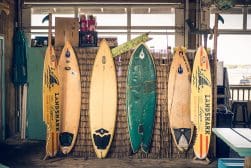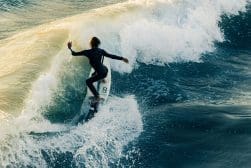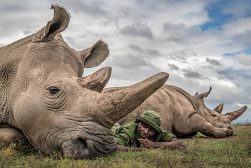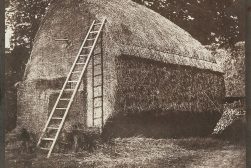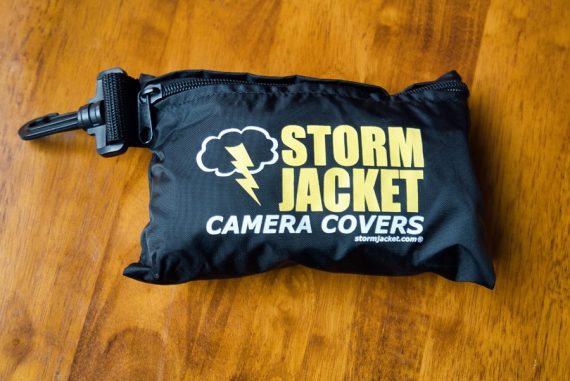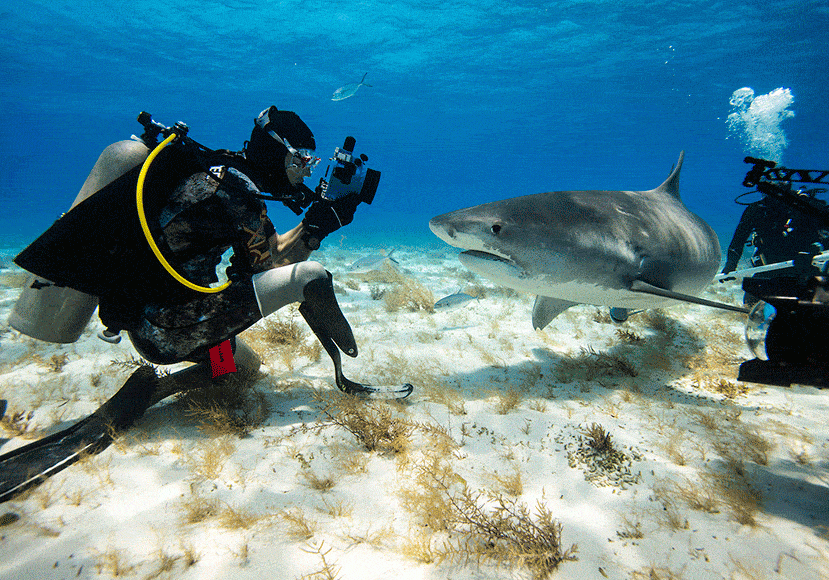
World’s Most Dangerous Photography Jobs
What are the most dangerous photography jobs in the world? From wild animals to warzones, let's take a look at what photographers will risk to get the shot!
Learn | By Tania Braukamper
Think of some dangerous professions. Did photography spring to mind? Probably not!
But here’s the thing: every day, there are photographers around the world putting their lives on the line. Or at the very least, putting their health and safety at risk to catch the perfect shot.
They are the warzone photojournalists, the storm chasers, the ones whose subjects for portrait sittings happens to have very sharp teeth… to name just a few!
So which photography jobs are the most dangerous in the world? Let’s take a look.
Storm Chasers

Storm chasing in Texas | © James Smart
There’s a storm brewing on the horizon. The dark clouds which hung listlessly before are being sucked into a swirling vortex that threatens to devour everything in its path. And it’s getting bigger by the second.
Do you: A) grab your things and run, or B) yell “woohoo!” and drive towards it?
If you’re sane, probably option A. If you’re the kind of photographer whose passion is wild weather, then it’s time to put the pedal to the metal.
What could possibly go wrong?

Tornado | © Mike Hollingshead
Lightning strikes, felled trees and power-lines, debris being thrown around and, of course, actually getting caught inside a tornado or other dangerous weather event are all potentialities of this genre.
That said, these risks are, in reality, relatively low.
“In a way, most of the danger doesn’t come in times of shooting things but usually in, say, heavy rain just navigating through or around storms without a good view” – storm photographer Mike Hollingshead.
So if you’re interested in taking up storm chasing as a hobby, be aware that a lot of the danger actually has to do with safe driving in risky conditions. Similarly, you need to be wary of other drivers who might be wildly fleeing in the opposite direction.
Tips for shooting storms
Here’s Mike: “I always have a window clamp with a mount to avoid having to get out of the car during lightning. It’s quite useful and also quicker than getting out and setting up a tripod.
Once dark, just set up the longer exposures (say between 2 and 30 seconds) and let it fire away without even touching the cable release… just in case a bolt happens to strike the car.”
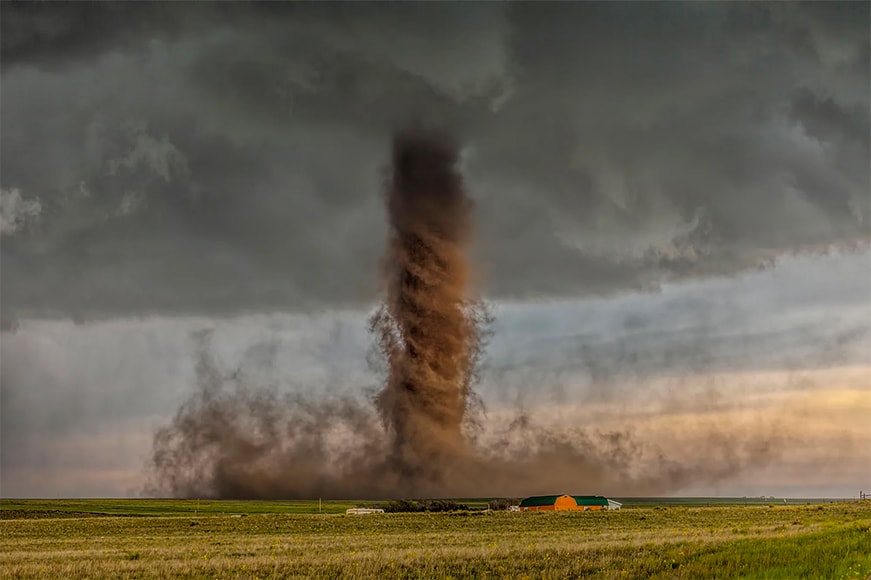
“Dirt” | © James Smart
Australian photographer James Smart – whose photograph “Dirt” took out the grand prize in the 2015 National Geographic Photography Contest – also suggests using a lightning trigger.
“Try using a lightning trigger for those daytime lightning strikes, as they are not the easiest to capture when you have to hit the shutter button – much easier at night when you can leave the shutter open for longer periods of time,” he told us.
He also suggests a fast shutter:
“When photographing storms, I try to shoot with a fast shutter, because they move/rotate quite fast, so you might need to crank up the ISO and open up for f/5 or higher to get the right amount of light in.”
Conflict photojournalism

Wounded soldiers in the Korengal Valley in eastern Afghanistan, October 2007 | © Lynsey Addario
It’s one thing to be on the front line of a war or humanitarian crisis as a trained soldier with a gun. It’s another to be in the same situation carrying nothing but a camera.
That’s the life of a conflict photojournalist. And it’s arguably the most dangerous job a photographer can get themselves into.
So why do they do it?
How Much Do You REALLY Know About Photography?! 🤔
Test your photography knowledge with this quick quiz!
See how much you really know about photography...

Pulitzer Prize-winning photojournalist Lynsey Addario says there’s no place she’d rather be than “on the front-line of history,” using her imagery to inform the public and policymakers about world events.
“There are so many misconceptions about why journalists cover war,” she told The Guardian. “It is a calling. It’s so much greater than an addiction to adrenaline.”
Read more on the importance of photojournalism and don’t miss these famous conflict photographers.
What could possibly go wrong?
For photographers in conflict zones, the threat of injury or death is very real.
Being shot at, bombed, held hostage, assaulted, trekked across harsh terrain or made to navigate fields peppered with landmines… these are just some of the possible risks included in the job description.
Addario herself has seen some intense situations (to put it lightly). Her list of dangerous encounters while out in the field includes being kidnapped – twice.
Here she is talking to NPR:
I remember the moment in which we were taken hostage in Libya, and we were asked to lie face down on the ground, and they started putting our arms behind our backs and started tying us up. And we were each begging for our lives because they were deciding whether to execute us, and they had guns to our heads.
In moments like those, with one’s very life hanging in the balance, photography may seem like a trivial pursuit.
But fearless photo professionals brush themselves off and keep going back – because they know that what they’re doing genuinely makes a difference.
Tips for photographing conflict
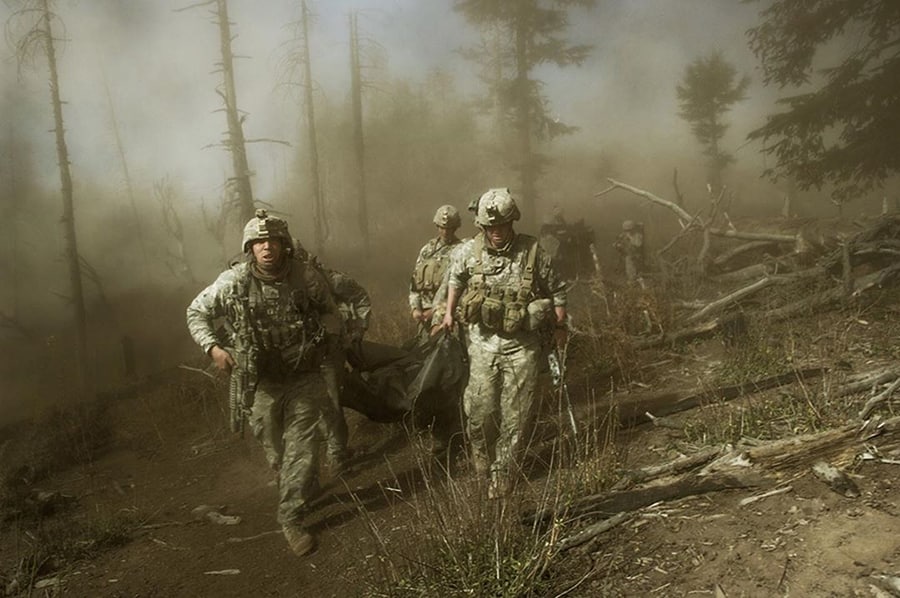
U.S. troops with the 173rd Airborne Battle Company, carrying the body of Staff Sgt. Larry Rougle (known as “Wildcat”) after he was killed in an ambush during Operation Rock Avalanche in the Korengal Valley, October 2007 | © Lynsey Addario
Having the right gear, and the right training, is obviously paramount in this field of work. Do your research – like learning a few basics of the local language.
On top of that, Addario offers up an unexpected piece of advice for budding photojournalists: Do try and make it beautiful.
“You have to get the reader to stop and realise: yes, it is as bad as it seems,” she says in the interview above.
“It’s not all about bravado and just showing up and shooting. If I have the time, I do think about composition. Because if no one stops to look at the picture, what’s the point of taking it? And if making it beautiful does that, that’s what I’m striving for. Sometimes there is beauty in war zones.”
Surf Photography
If you’re scared of any wave over half a meter and freak out every time a piece of seaweed brushes your leg, surf and sea photography probably aren’t for you.
Photographers who wet-suit up put their expensive gear in a waterproof housing, and brave the unpredictable other-world that is the ocean deserve full respect. It’s not the easiest – or safest – of jobs.
What could possibly go wrong?
Surf photographers must be willing to face merciless waves and wicked undertows – as well as the possibility of being hit by a surfer or stray board.
The video above shows the lengths a surf photographer might go to in order to get a shot from right inside the barrel.
Not to mention that in some cases the photographer has to be about as fit and skilled as the actual athlete!
Tips for shooting surf

What it takes to get the shot | © Trent Slatter
Big wave surf photographer Trent Slatter captures the gorgeous ferociousness of the sea in all her glory.
Waves appear like blue glass caught in motion before shattering, each one a unique and unrepeatable event.
Capturing such shots isn’t easy, but that’s part of the exhilaration. As Trent tells us: The greater the risk, the bigger the reward.
It also requires a degree of letting go – letting go of fear, of limitations, of the opinions of others.
Here’s Slatter talking to Daily Salt:
“Throwing caution to the wind and going for broke can be an exhilarating feeling and can really show oneself how as humans what we can achieve. My life is different to yours and vice versa so comparing yourself to someone else is the worst thing I’ve ever done, and no longer will. You don’t need a double tap on IG to measure an image. That shit will destroy your soul. And be kind to others.”
Deep Sea & Shark Photography
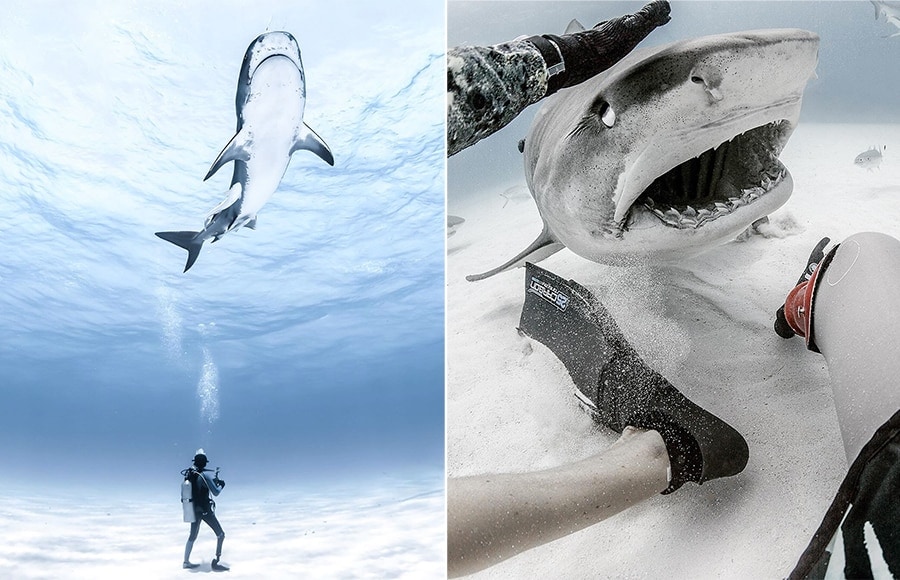
Deep diving with sharks | © Mike Coots
Let’s all take a moment to tip our hats to underwater ocean photographers – aka, those whose job involves braving deadly sea creatures and an unhealthy reliance on a tank of oxygen.
So what would possess someone to make photographing all things deep and dangerous their life’s work?
For that question, we turn to shark advocate and photographer Mike Coots. It was after loosing his right leg in a shark attack that he decided to spend his life not only documenting the beauty of these creatures, but also lobbying for their protection.
Yes, you read that right.
Mike told me once in an interview that the goal of his photography is to use visual storytelling to show “just how beautiful, fragile, and special our oceans are”… and I think there’s definitely something in that.
What could possibly go wrong?
Ever seen the movie Jaws?
Enough said!
Tips for photographing creatures of the deep

Mike gets up close and personal with a shark | © Mike Coots
Here’s a key tip from Mike on shooting safely underwater: Be comfortable in your diving.
“Underwater photography can be technically difficult and consume your entire thought process during the dive,” he says.
“You want your dive gear on point, and your diving experience to be second nature. If you are fiddling with gear, constantly defogging your mask, underweighted, etc., you won’t be able to get into a comfortable shooting rhythm and it may inhibit your ability to stay keenly aware of the shark’s behavior.”
P.s. Mike’s Instagram is seriously packed with stunning photography. You can follow him here.
Conservation Photography
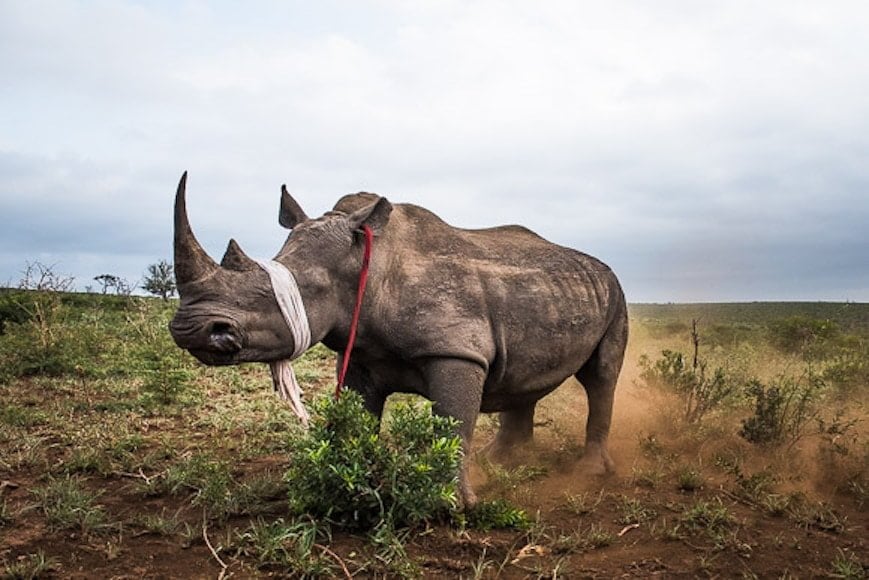
Rhinos are hunted for their horns | © Peter Chadwick
There are tens of thousands of species on Earth under threat of disappearing. Some are great and majestic, some sprightly and small; some are losing their habitats and others being hunted to extinction.
Without our care and protection, we may lose them forever.
Conservation photography is one way of making a difference. Here we have professionals whose weapon of choice is a camera – and they use it to raise awareness of conservation issues and advocate for positive change.
Not all types of conservation photography are dangerous. But the genre certainly can involve a dark and tangled web of risks – especially where illegal hunting and poaching are involved.
What could possibly go wrong?

Blood | © Peter Chadwick
As someone with decades of experience in conservation management and photojournalism, Peter Chadwick has intimate knowledge of the genre.
As Peter told us in his Shotkit feature, conditions for the serious conservation photographer can be dicey:
In order for me to gather the needed material, I accompany the counter-poaching ranger teams as they undertake their duties and patrols. Some of these patrols may take place in extremely rugged terrain where temperatures will exceed 38°C and where the patrols may cover up to 30-40km in a single day.
“Over and above this,” adds Peter, “there is also the constant risk of contracting tropical diseases, getting into contact with heavily armed poaching gangs and encounters with dangerous game such as lion, elephant, and buffalo.”
Tips for conservation photography

Anti-poaching rangers face a risk of death and injury | © Peter Chadwick.
Here are four key tips from Peter for anyone trying to follow in his line of work:
- Do an advanced first aid course that focuses on dealing with trauma type wounds.
- Undertake a course that teaches one how to operate in hostile environments.
- Always research as much as you can about the political and security environment in the area that you will be working.
- Try and find a trustworthy local “fixer” that speaks the local language, understands the local situation and can assist in getting you around without hassles.
As for your gear – make sure it’s tough, durable, and compact.
Here are some recommendations on cameras for hiking, which should set you in good stead.
Sports & Adventure Photography
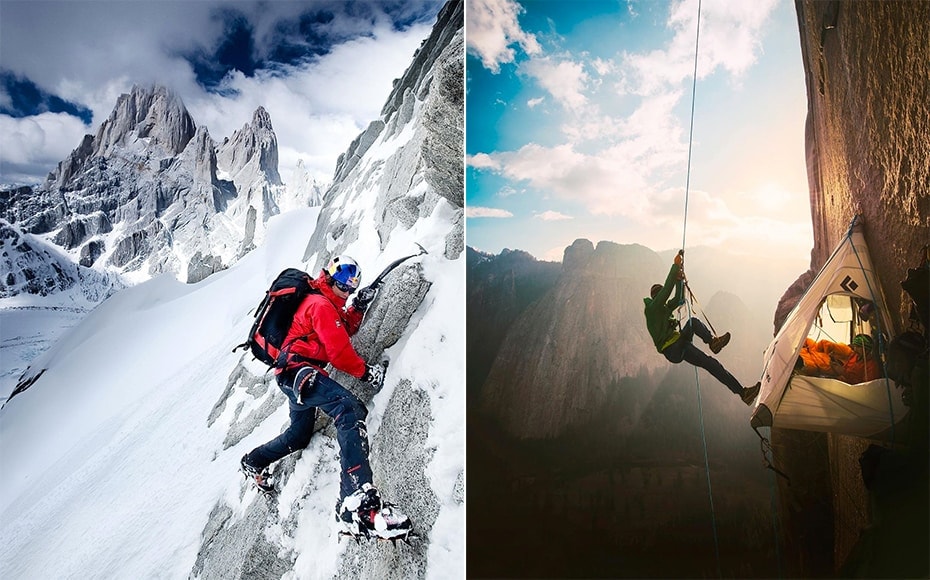
Left: David Lama climbing Cerro Torre in Patagonia, Argentina. Right: Tommy Caldwell and Kevin Jorgeson climb the Dawn Wall of El Capitan, an ascent dubbed the hardest rock climb in the world. | © Corey Rich
While we’ve given a dedicated mention to surf photography for having its own unique set of challenges, there are all kinds of sports, extreme sports and adventure activities that can just as easily make this list.
Think of the skiers, the rock climbers, the mountaineers, the cave divers, the bungee jumpers… and all the others whose antics make the hearts of us less daring types palpitate.
Now think of the photographers who bravely follow them wherever they dare to go.
What could possibly go wrong?
In his book The Stories Behind the Images: Lessons from a Life in Adventure Photography, adventure photographer Corey Rich recounts a time when his quest to get the perfect shot nearly cost him his life.
While photographing rock climber Tommy Caldwell, Rich untied the knot at the end of his own rope to stop it getting in the way of his shot. With a 600m drop below him, Rich proceeded to snap away – completely forgetting he’d untied the knot and nearly repelling right off the end.
Thankfully, Caldwell noticed at the last second and stopped him from plunging to his death.
Rich’s story demonstrates just one of the many things that can go horribly wrong while shooting adventure sports. Dangling from ropes, trekking up mountains in harsh conditions, putting yourself in the direct path of fast-moving people and objects… It’s all in a day’s work.

KPL World Champion, Ewan Jaspan | © Athol Hill
Speaking of fast-moving objects, how do you avoid getting ploughed down by speeding sportspeople?
“You learn to trust some riders more than others,” says sports photographer Athol Hill.
“The guy in the above picture is a world champion kite-boarder, so you know if you ask him to jump at a point, there is a low risk of contact. He would have launched about a meter or two from me. The part at the bottom is the wave caused by his launch going over me.
I’m not worried too much about riders like him – it’s the lesser skilled riders who try to jump over you that I get worried about. But it’s part of the fun.”
Tips for sports photography
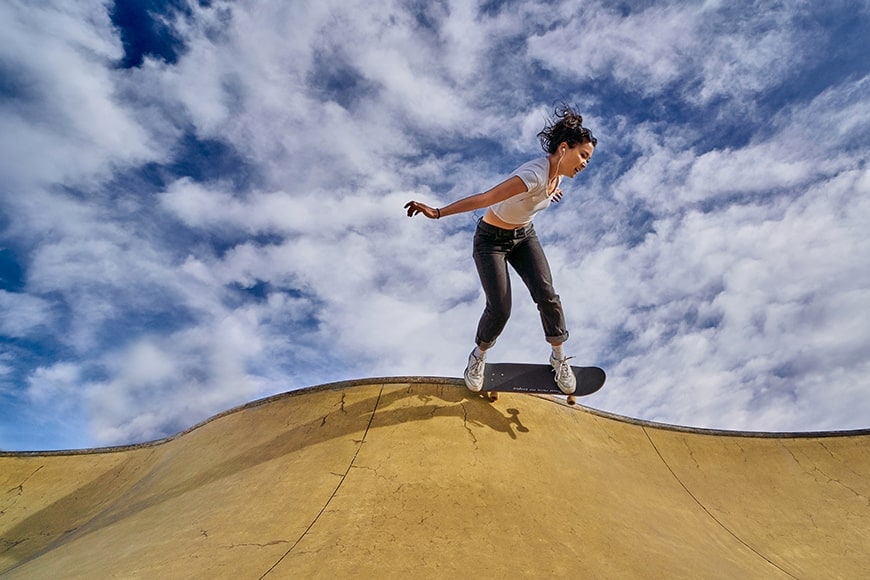
Angling your shot upwards can create a completely different effect. | © Athol Hill
Here’s some handy advice from Athol:
“My biggest tip is to throw conventional photography constraints out of the window and think of them as opportunities.
Don’t just assume something isn’t possible. Sports photography is about taking risks and breaking rules with the composition and angles of your photos.
As a simple example, if you look horizontally towards the horizon, the sky has a washed-out light blue look. If you look up, it’s dark blue.
If you take photos of riders upwards, you change the entire dynamics of the photo. Now you have dark blue sky, no background obstacles and you make the rider look higher.
Sports photography is about finding ways to overcome the constraints, not just taking photos. Buy a water-housing, use a remote trigger so you can put your camera in the action, speak to riders, whatever the answer is, try to make it happen.”
Final Words
It’s easy to look at a photograph and see only what’s in the frame.
Next time you see a shot of a hungry tornado, a savage wave, a roaring animal or a bullet-flecked war-zone, take a moment to imagine what went on behind the camera.
Who pressed the shutter button? How did they feel, and what risks did they take to do it?
There’s a whole world outside the frame, if only we get to hear the stories.
As for you: If living life on the edge, camera in hand, sounds like a dream come true, perhaps it’s time for a change of career (or genre). Hopefully this post gave you some ideas and inspiration. Let us know what your plans are in the comments.
Disclaimer: All recommendations are impartial and based on user experience, with no bias to the products or the brand. The products in this post may contain affiliate links.
All photos reproduced with permission.

Check out these 8 essential tools to help you succeed as a professional photographer.
Includes limited-time discounts.





